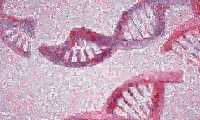
06 Aug AI Algorithms Deduce Genetic Mutations from Biopsy Specimens
MedicalResearch.com Interview with:

Dr. Gerstung
Moritz Gerstung PhD
Group Leader: Computational cancer biology
EMBL-European Bioinformatics Institute
MedicalResearch.com: What is the background for this study?
Response: We have learned a lot in the last ten years about the molecular nature about various cancers thanks to the resources created by TCGA, ICGC and many other initiatives. Similarly, digital pathology has progressed hugely due to new AI algorithms. Yet it hasn’t been explored deeply how a cancer’s genetic makeup and its histopathological appearance are related. Here computers can be very helpful as they can process large amounts of digital microscopy slide images and test whether there are any recurrent histopathological patterns in relation to hundreds or thousands of genetic and other molecular abnormalities.

DNA Mosaic
MedicalResearch.com: What are the main findings?
Response: We used an AI algorithm to characterise histopathological patterns and tested whether they correspond to a broad range of genetic alterations in 28 cancer types. We found that 167 different mutations are accompanied by histopathological characteristics. In some cases these patterns are very distinctive and the histopathological patterns are part of known subtypes such as BRAF mutations in tall cell thyroid cancer or EGFR amplifications in the small cell variant of glioblastoma. In other cases the patterns are more subtle, such as increased nuclear sizes in tetraploid carcinomas. What was remarkable was that we found associations for any type of alteration and in almost every cancer type.
MedicalResearch.com: What should readers take away from your report?
Response: It turns out that AI algorithms have become very powerful in detecting patterns in medical images. This helps better understand how mutations influence a tumour’s appearance. As histopathological information is often readily available it may provide clues about the cancer‘s nature when molecular tests are unavailable, could help interpret genetic variants of unknown significance and lastly serve as an additional and rich layer of information in developing combined genomic and histopathological subtypes. This will help deliver more accurate prognoses and may help inform better treatment decisions.
MedicalResearch.com: What recommendations do you have for future research as a result of this work?
Response: It turns out that AI algorithms have become very powerful in detecting patterns in medical images. This helps better understand how mutations influence a tumour’s appearance. As histopathological information is often readily available it may provide clues about the cancer‘s nature when molecular tests are unavailable, could help interpret genetic variants of unknown significance and lastly serve as an additional and rich layer of information in developing combined genomic and histopathological subtypes. This will help deliver more accurate prognoses and may help inform better treatment decisions.
MedicalResearch.com: Is there anything else you would like to add?
Response: Even with 17000 cancer slides we have just been scratching the surface. With better algorithms and larger digital image data sets we will be able to learn much more about specific alterations. Larger cohorts will also facilitate refining the algorithm’s ability to discriminate certain mutations such that a computer may deliver an accurate histopathology based prediction of the mutation status. This won’t work for all mutations, but may become possible for some alterations, for example microsatellite instability, which was demonstrated recently.
Citation:
Fu, Y., Jung, A.W., Torne, R.V. et al. Pan-cancer computational histopathology reveals mutations, tumor composition and prognosis. Nat Cancer (2020). https://doi.org/10.1038/s43018-020-0085-8
JOIN OUR EMAIL LIST
[mailpoet_form id="5"]We respect your privacy and will never share your details.
Last Modified: [last-modified]
The information on MedicalResearch.com is provided for educational purposes only, and is in no way intended to diagnose, cure, or treat any medical or other condition. Always seek the advice of your physician or other qualified health and ask your doctor any questions you may have regarding a medical condition. In addition to all other limitations and disclaimers in this agreement, service provider and its third party providers disclaim any liability or loss in connection with the content provided on this website.
Last Updated on August 6, 2020 by Marie Benz MD FAAD
